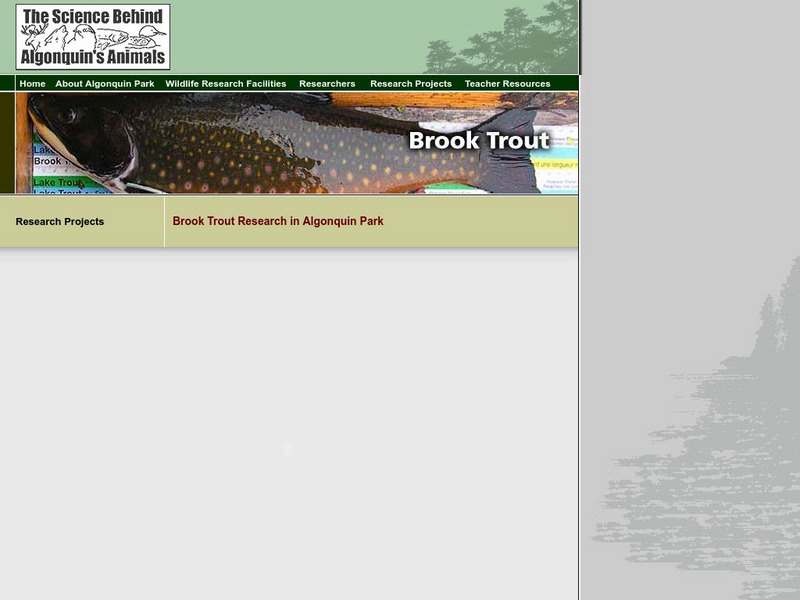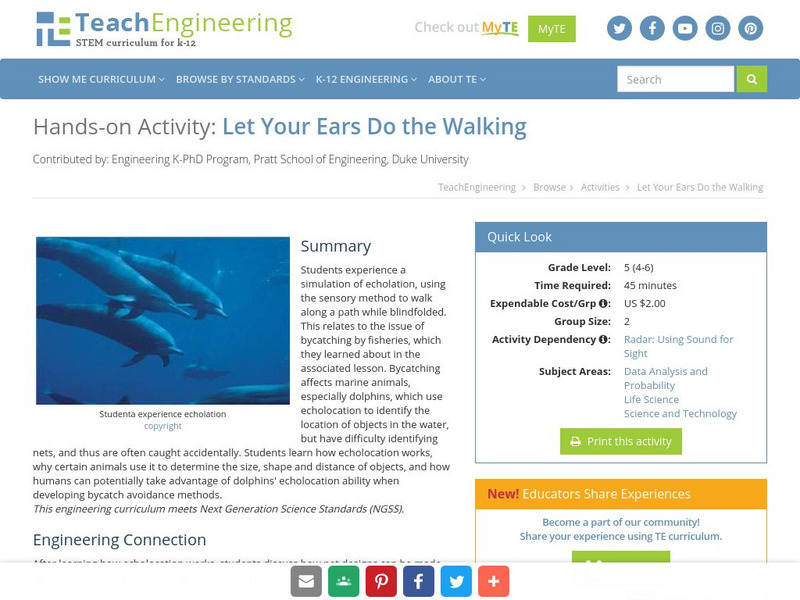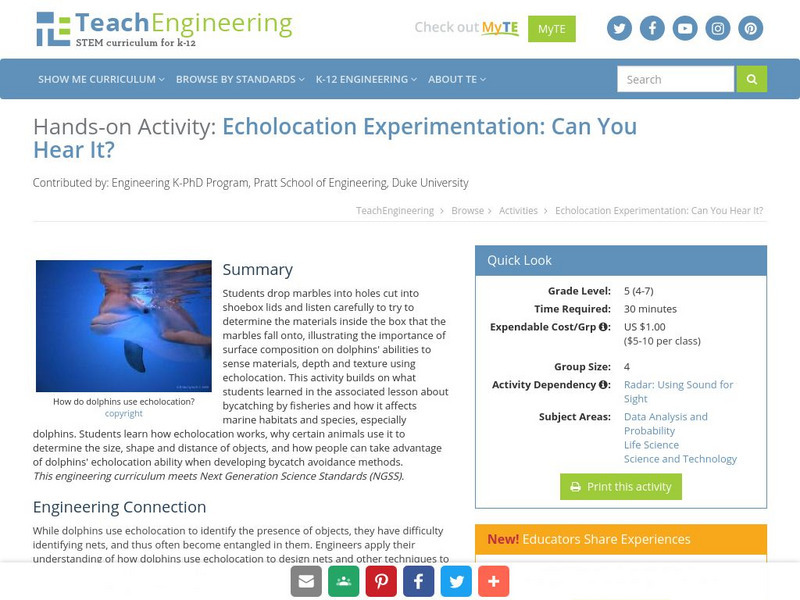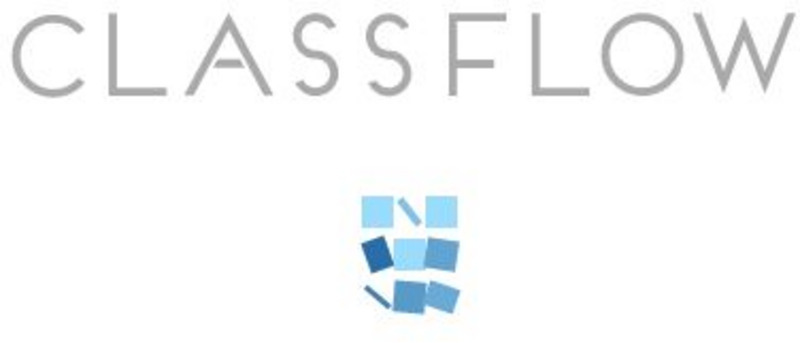Sea World Parks & Entertainment
Sea World: Bony Fish Diet and Eating Habits
This site provides a general rundown of the diet and eating habits of bony fish. Content includes a focus on food preferences and resources, food intake, methods of collecting and eating food, and fish as biological control agents.
National Geographic
National Geographic: Fisheries
In this lesson plan, students explore issues related to fisheries sustainability and simulate fish monitoring methods commonly used by scientists and resource managers.
National Geographic
National Geographic: Coral Reef Fish Survey Simulation
Students will learn surveying methods for an ecosystem through a short video. The video focuses on exploring the number and types of fish and the health of the coral reef ecosystem. Site includes a lesson plan and activity worksheet.
Science Education Resource Center at Carleton College
Serc: Lab 6: And on His Farm He Had Some Fish
A lab experiment in a series of experiments that investigates fisheries. In this particular lab, students learn about the aquaculture methods by analyzing FAO aquaculture data. They will also investigate the change to coastal landscapes...
TED Talks
Ted: Ted Ed: How I Fell in Love With a Fish
Chef Dan Barber squares off with a dilemma facing many chefs today: how to keep fish on the menu. With impeccable research and deadpan humor, he chronicles his pursuit of a sustainable fish he could love and the foodie's honeymoon he's...
Better Lesson
Better Lesson: The Fishing Trip
What good fishing trip isn't without a good story or two? Today the students will solve comparison story problems involving different lengths of fish.
Khan Academy
Khan Academy: Covered Jar With Fish in Lotus Pond
This piece, from the Avery Brundage Collection of the Asian Art Museum in San Francisco, illustrates a method of polychrome decoration in which painting, as well as firing, occurred twice: preceding glaze and over previously fired glaze....
Other
North Dakota Game and Fish Department: Small Game Hunting Guide
A detailed guide of regulations for hunting various small game in North Dakota. Covers seasons, hunting methods, animal identification, federal laws, poacher reporting, and much more. Each type of small game is accompanied by a map...
National Council of Teachers of Mathematics
Nctm: Figure This: How Many Fish in the Pond?
Can you figure out how many fish are in a pond? Use the statistical method of capture-recapture and estimation to solve this math challenge. An investigation from the NCTM Math Challenges for Families series. Discover how this skill can...
Friends of Algonquin Park
The Science Behind Algonquin's Animals: Brook Trout Research
It is a difficult job to determine the population of fish in a lake. Using a mark-recapture method gives researchers an accurate estimate of the fish population in a lake. As a researcher, your job at this activity, is to capture Brook...
Other
Monterey Bay Aquarium: Seafood Watch Program
This resource is devoted to determining the types of seafood that you should and should not purchase, how fish are farmed and caught and what you can do to improve the awareness of sustainable methods of fish farming. Be sure to click on...
TeachEngineering
Teach Engineering: All Caught Up
Commercial fishing nets often trap unprofitable animals in the process of catching their target species. In the following activity, students will experience the difficulty that fishermen experience while trying to isolate a target...
TeachEngineering
Teach Engineering: Let Your Ears Do the Walking
In the previous lesson, students learned about the issue of bycatching by fisheries and how it affects marine habitats. Dolphins are one of the main species affected by bycatching. Dolphins use echolocation to identify the location of...
TeachEngineering
Teach Engineering: Can You Hear It?
In the previous lesson, students learned about the issue of bycatching by fisheries and how it affects marine habitats. Dolphins are one of the main species affected by bycatching. While dolphins can use echolocation to identify the...
Better Lesson
Better Lesson: Keeper or Not a Keeper?
First graders measure fish to determine if the fish is a keeper or not a keeper. In doing so, they also tackle rigorous measurement questions!
BiologyWise
Biology Wise: Facts About Daphnia (Water Fleas)
Describes the physical characteristics of Daphnia, their importance as a food source for freshwater fish, their diet, life cycle, and methods of reproduction. Offers tips for how to start and maintain a colony of Daphnia that can be used...
Precision Nutrition
Encyclopedia of Food: Pistachios
Get a close up look at the nutrition, methods of selection, and a recipe for pistachios.
TeachEngineering
Teach Engineering: Dams
Through eight lessons, students are introduced to many facets of dams, including their basic components, the common types (all designed to resist strong forces), their primary benefits (electricity generation, water supply, flood...
Other
Explore Learning: Estimating Population Size
Adjust the number of fish in a lake to be tagged and the number of fish to be recaptured. Use the number of tagged fish in the catch to estimate the number of fish in the lake. (Free usage is limited to five minutes per day.)
ClassFlow
Class Flow: Decimal Word Forms
[Free Registration/Login Required] This interactive flipchart uses a circle and conquer method to read and write decimals through the ten-thousandths using a fun fish theme.














